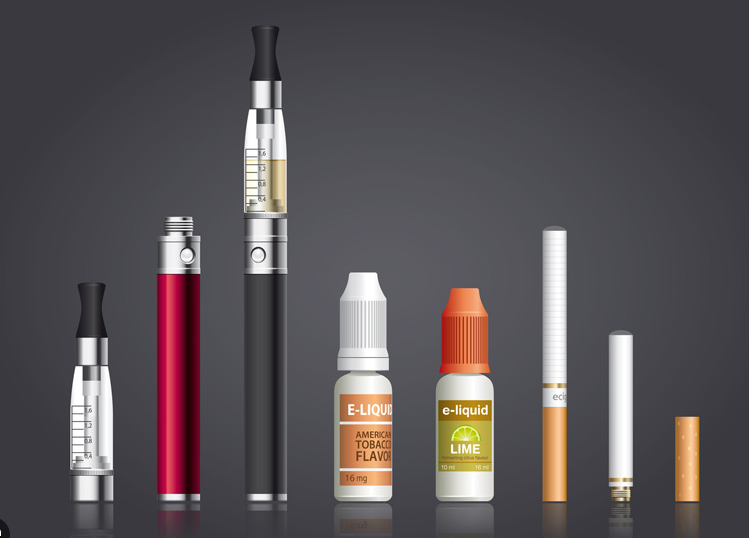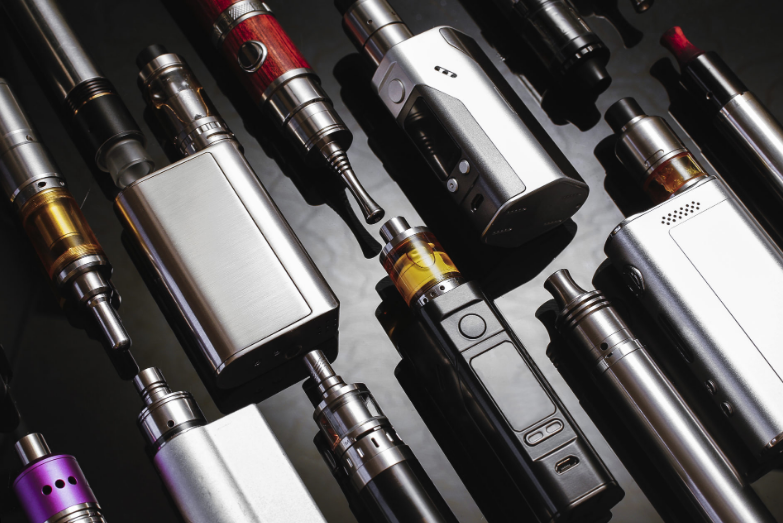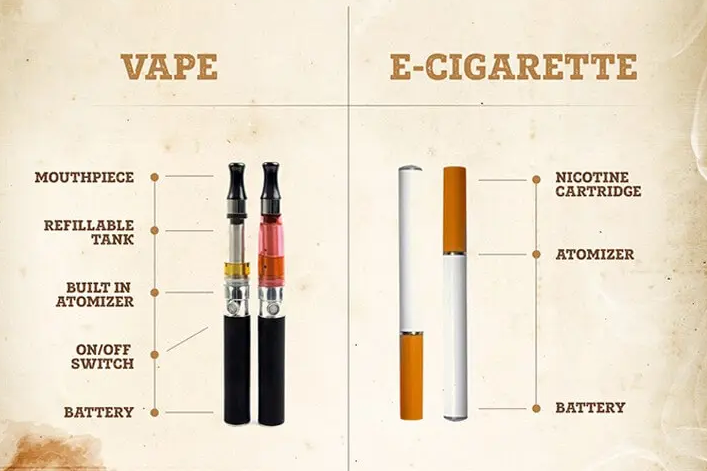E-cigarettes are designed to mimic traditional cigarettes and often use pre-filled cartridges, while vape devices offer customizable options and can produce more vapor.
Definitions and Key Differences
Definition of E-cigarettes
Electronic cigarettes, commonly known as e-cigarettes, are devices designed to simulate the act of tobacco smoking. They work by heating a liquid solution, which typically contains nicotine, propylene glycol, glycerin, and flavorings, to create an aerosol, often referred to as vapor, which the user inhales. E-cigarettes were introduced into the market in the early 2000s as a potential harm reduction tool for smokers looking to quit. The typical e-cigarette resembles traditional cigarettes in shape and size, making them discreet and easy to use for transitioning smokers.

Definition of Vape Devices
Vape devices, broadly referred to as vaporizers, encompass a wide range of electronic devices including but not limited to vape pens, mods, and pod systems. These devices also vaporize a liquid solution (e-juice) that may contain nicotine, flavorings, and other substances. Unlike e-cigarettes, vape devices are available in a variety of shapes and sizes, from small pen-like devices to large box mods. Vape devices are known for their customizable features, such as adjustable power settings and interchangeable components, which allow users to modify the vapor production and overall experience.
Fundamental Differences
Design and Customizability
E-cigarettes are typically designed to mimic traditional cigarettes in appearance and offer limited customization. Most e-cigarettes are non-refillable and disposable, intended for single use or equipped with pre-filled cartridges. On the other hand, vape devices are highly customizable, offering users the ability to adjust power settings, airflow, and temperature. Vape devices also allow for the use of refillable tanks, giving users the freedom to choose from a wide variety of e-juice flavors and nicotine strengths.
Performance and Experience
When it comes to performance, vape devices generally offer a more powerful and customizable vaping experience. Vape mods can reach power outputs up to 200 watts, producing denser vapor and more intense flavors. E-cigarettes, in comparison, operate at lower power levels, usually between 6 to 30 watts, providing a more controlled and cigarette-like experience. This difference in power affects the vapor production, throat hit, and overall satisfaction of the user, making vape devices more appealing to experienced vapers seeking a more robust experience.

Components and Functionality
Components of E-cigarettes
E-cigarettes are comprised of three main components: a battery, an atomizer, and a cartridge or pod.
- The battery is the power source, usually a lithium-ion battery, which is rechargeable and powers the atomizer. The battery capacity in e-cigarettes typically ranges from 100 to 300 mAh, offering enough power for a day’s use for an average user.
- The atomizer is the heating element that vaporizes the e-liquid. It contains a coil that heats up when electricity is applied, turning the liquid into vapor.
- The cartridge or pod holds the e-liquid or vape juice. In disposable e-cigarettes, the cartridge is pre-filled and designed for single use. Rechargeable models use refillable pods or cartridges, allowing users to choose their e-liquid.
Components of Vape Devices
Vape devices have more complex components, including a battery, an atomizer, a tank, and often a digital display with control buttons.
- The battery in vape devices is larger and more powerful than those found in e-cigarettes, with capacities ranging from 1500 to 5000 mAh. This allows for longer use between charges and the ability to adjust the power output, typically from 5 watts to over 200 watts, depending on the device.
- The atomizer in vape devices is more advanced, offering replaceable coils and the option to customize the resistance level, which can affect the vapor production and flavor intensity.
- The tank holds the e-liquid and is refillable, offering a larger capacity than e-cigarette cartridges, usually between 2ml to 8ml. This means users can vape longer without needing to refill.
- A digital display and control buttons allow users to adjust settings such as temperature, power, and airflow, providing a personalized vaping experience.
How They Work
Both e-cigarettes and vape devices operate on the same basic principle of heating e-liquid to produce vapor, but the functionality and performance differ significantly due to their design and components.
E-cigarettes work by activating a sensor when the user takes a puff. This sensor turns on the battery, which powers the atomizer. The heat from the atomizer’s coil vaporizes the e-liquid in the cartridge, producing vapor that is inhaled through the mouthpiece. The process is straightforward, with minimal adjustments available to the user, focusing on simplicity and ease of use.
Vape devices, on the other hand, offer a more interactive experience. Users can manually turn on the device and adjust settings through the control buttons and digital display. By selecting the desired power output, temperature, and airflow, users can customize the density and flavor of the vapor. When the user presses the fire button, the battery sends power to the atomizer, heating the coil. The heated coil vaporizes the e-liquid in the tank, creating vapor that is inhaled through the mouthpiece. This manual control allows for a more tailored vaping experience, with the capability to produce larger clouds of vapor and more intense flavors.
Types and Variations
Types of E-cigarettes
E-cigarettes come in various forms, each designed to cater to different preferences and usage habits. The main types include:
| Type | Description | Key Features |
|---|---|---|
| Cig-a-likes | These devices resemble traditional cigarettes and are among the first-generation of e-cigarettes. They are simple in design and easy to use. | – Small and lightweight<br>- Automatic or manual battery<br>- Pre-filled or refillable cartridges |
| Vape Pens | Slightly larger than cig-a-likes, vape pens offer better battery life and the ability to refill with e-liquid of choice. | – Longer battery life (usually around 650 mAh)<br>- Refillable tanks<br>- More vapor production |
| Pod Systems | Compact and easy-to-use devices that use pre-filled or refillable pods. They are popular for their portability and simplicity. | – Ultra-portable<br>- Pre-filled or refillable pods<br>- Higher nicotine concentrations available |
Varieties of Vape Devices
Vape devices, unlike the relatively simple e-cigarettes, come in a variety of forms with a range of features designed for both beginners and experienced users. The varieties include:
| Variety | Description | Key Features |
|---|---|---|
| Vape Mods | Advanced devices that offer extensive customization options, including adjustable wattage, temperature control, and replaceable batteries. | – High power output (up to 200 watts or more)<br>- Customizable settings<br>- Replaceable batteries |
| Vape Pens | Similar to e-cigarette vape pens but with more advanced features like adjustable power settings and larger e-liquid capacity. | – Versatile and portable<br>- Adjustable settings<br>- Larger e-liquid capacity than e-cigarette vape pens |
| Pod Mods | A hybrid between pod systems and more advanced vape mods, offering the simplicity of pod systems with the performance and customization options of vape mods. | – Compact and easy to use<br>- Replaceable pods with the option of using different e-liquids<br>- Adjustable power |
Each type and variety cater to different vaping needs, from those looking for a simple, discreet experience similar to smoking cigarettes to those seeking a highly customizable vaping experience. Cig-a-likes and pod systems are ideal for smokers transitioning to vaping, offering ease of use and portability. Vape pens serve as a middle ground, providing more power and vapor production without the complexity of mods. Vape mods and pod mods, with their advanced features, cater to experienced vapers who prioritize performance and customization.

Health and Safety Considerations
Health Impacts of E-cigarettes
E-cigarettes are often marketed as safer alternatives to traditional tobacco smoking, but they are not without health risks. The primary concern is the inhalation of nicotine, which is highly addictive and can increase blood pressure and heart rate. Studies have shown that e-cigarette vapor contains significantly fewer toxic substances than conventional cigarette smoke, but it is not free of harmful chemicals such as formaldehyde, acetaldehyde, and acrolein, which can cause lung disease and cardiovascular disease.
Another significant health concern is the impact on adolescent brain development. Nicotine exposure during adolescence can harm the developing brain, affecting attention, learning, and susceptibility to addiction. Despite the reduced harm compared to smoking, e-cigarettes should not be considered completely safe. The long-term health effects of e-cigarette use are still under investigation, but early evidence suggests a potential link to chronic lung conditions and cardiovascular issues.
Health Impacts of Vaping
Vaping with more advanced devices, such as vape mods and pod mods, presents similar health risks to those associated with e-cigarettes, primarily due to nicotine and exposure to harmful chemicals. However, the customizable nature of these devices can lead to higher exposure levels. For instance, higher power settings can increase the concentration of toxicants in the vapor. Vape devices that operate at higher temperatures can potentially produce more harmful chemicals, increasing the risk of respiratory problems and other health issues.
The use of flavored e-liquids has also raised concerns about respiratory health. Some flavoring compounds, like diacetyl, have been linked to serious lung diseases such as bronchiolitis obliterans, commonly known as “popcorn lung.” While the direct health impacts of many flavoring substances are still being studied, their safety when inhaled over long periods remains uncertain.
Safety Concerns
Safety concerns related to vaping and the use of e-cigarettes also include the risk of battery explosions and chemical burns. There have been reports of e-cigarettes and vape devices exploding, causing injuries. These incidents are often attributed to battery malfunctions, improper handling, or the use of unauthorized chargers.
Another safety concern is the risk of poisoning, especially in children, from the ingestion of e-liquid. Nicotine is a toxic substance, and e-liquids, particularly those with high nicotine concentrations or appealing flavors, pose a poisoning risk if ingested or absorbed through the skin.